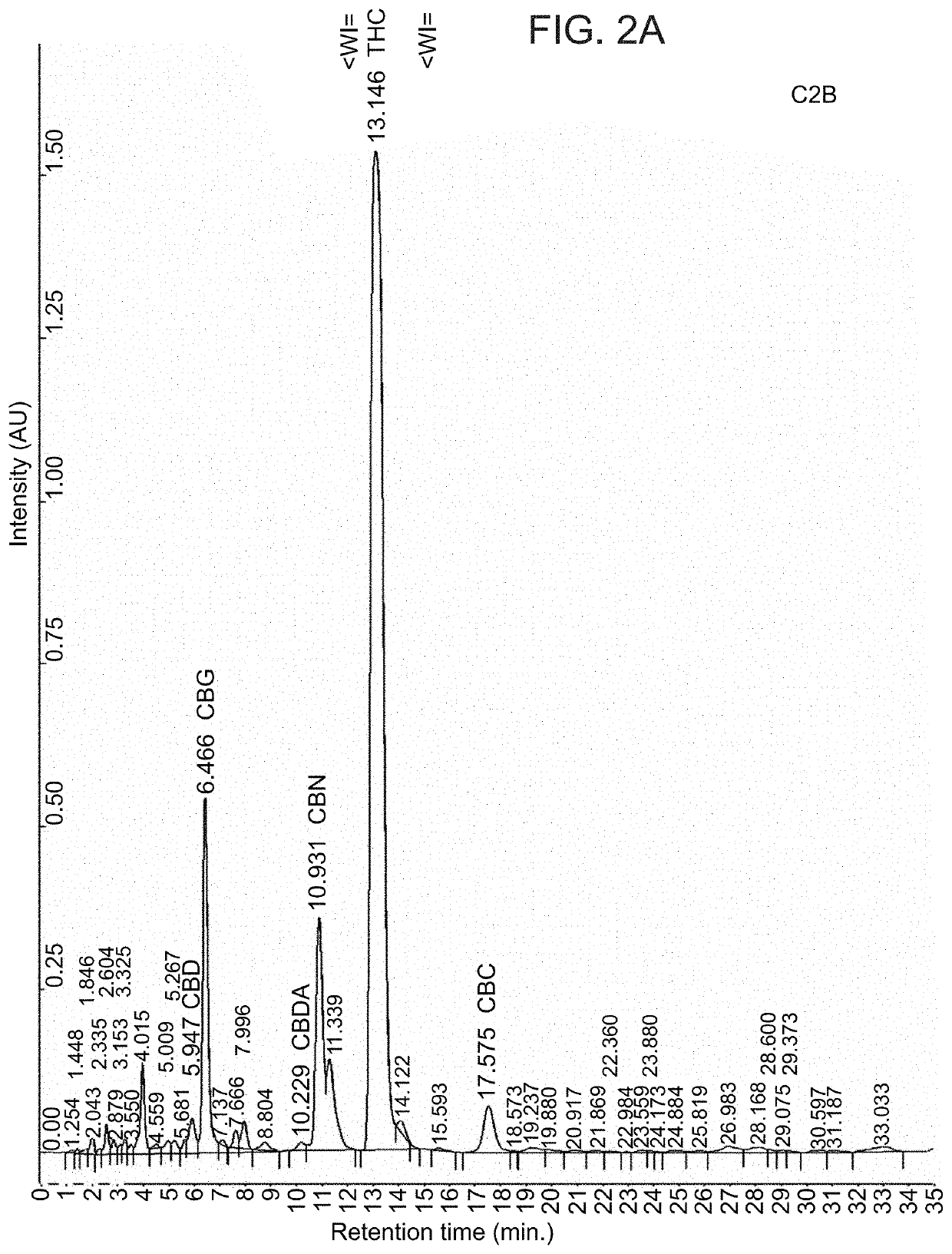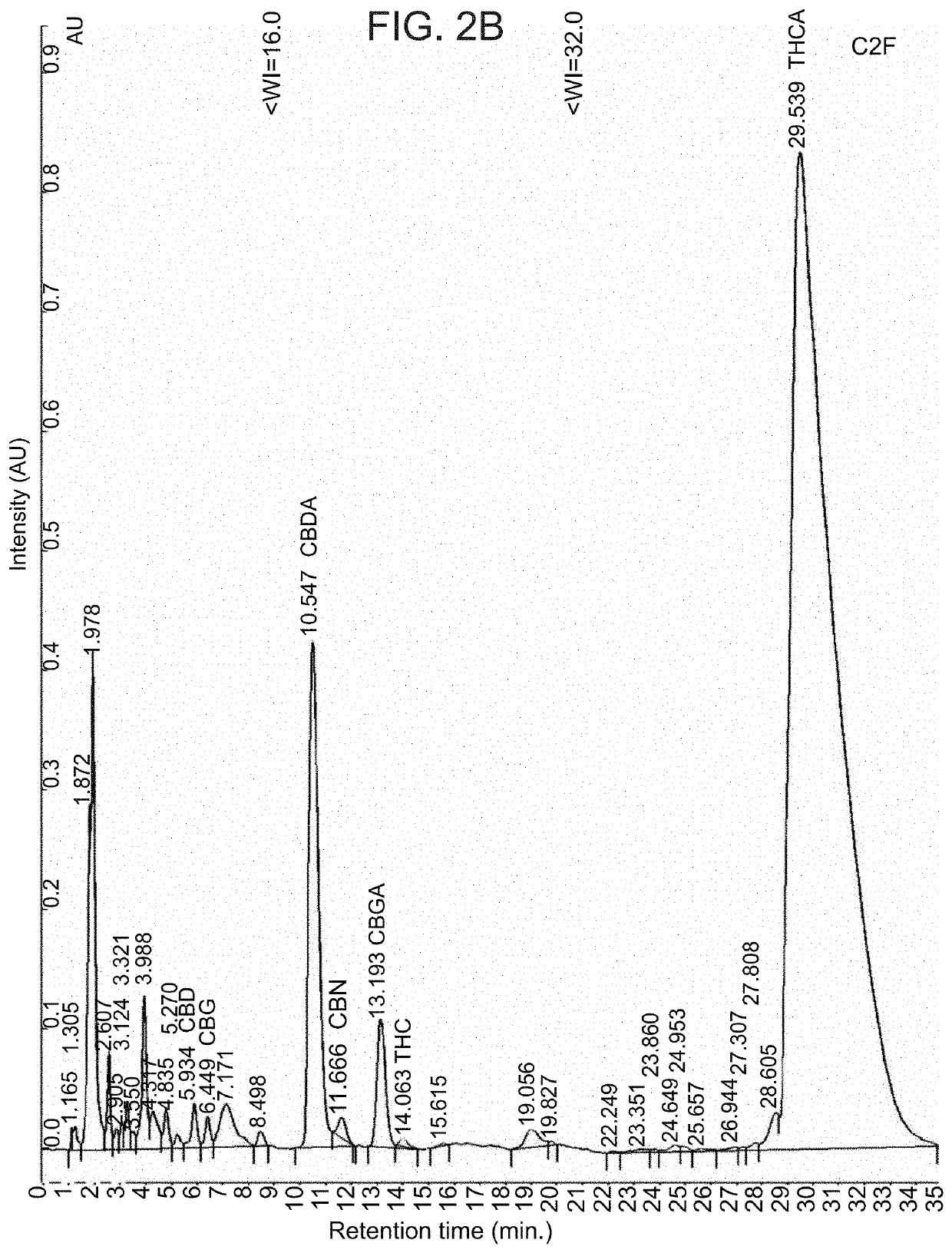Compositions and methods for treating cancer
a cancer and composition technology, applied in the field of compositions and methods for the treatment of cancer, can solve the problems of incomplete and effective treatment that have not yet been developed
- Summary
- Abstract
- Description
- Claims
- Application Information
AI Technical Summary
Benefits of technology
Problems solved by technology
Method used
Image
Examples
example 1
C. sativa Extracts from Fresh Inflorescences are Active in Reducing Cell Viability in Colon Cancer Cell Lines
[0483]Cytotoxic activity was determined as the level of cell viability in HCT116 cells for absolute ethanol extracts of fresh (C2F) and heated (C2B) inflorescences of C. sativa (CS12 var.) following overnight treatment. Treatments with C2F or C2B were found to significantly reduce HCT116 cancer cell viability with a similar level of activity (FIGS. 1A, 1B). Moreover, although both ethanol-extracts of C. sativa, C2F and C2B, have similar cytotoxic activity on colon cancer cells HCT116 (FIGS. 1A, 1B), the activity of C2F on CCD18 healthy colon cells was reduced. C2F had IC50 of 83.9 and 144.2 μg / mL on HCT116 and CCD18 cell lines, respectively (FIGS. 1A, 1C). On the other hand, C2B was more active on CCD18 than on HCT116 cell lines, with IC50 of 54.63 and 84.1 μg / ml, respectively (FIGS. 1D, 1B).
example 2
Chemical Composition of C. sativa Extracts from Fresh and Baked Flowers
[0484]HPLC chromatogram and main active compounds were determined for C2F and for C2B (FIGS. 2A-B and Table 1, below).
TABLE 1HPLC peak area and % of area for Cannabis fresh and baked flowersC2FKnownC2BKnownRTArea of peak% of AreacompoundRTArea of peak% of Areacompound5.93456402100.42CBD5.94796253481.15CBD6.44936140800.27CBG6.4668435917610.11CBG10.5471150958408.72CBDA10.22925651120.30CBDA11.66635920900.27CBN10.931-11.33910078426012.08CBN13.193255122801.93CBGA13.14651830355262.13THC14.06314761780.11THC17.575229811202.75CBC29.539100632915276.29THCA
[0485]Eight major cannabinoids were identified in the fresh and baked crude extracts at 220 nm. These peaks were identified as CBD, CBG, CBDA, CBN, CBGA, THC, CBC and THCA, with retention times of 5.9, 6.4, 10.5, 11.6, 13.1, 14.0, 17.5 and 29.5 minutes, respectively, relative to the HPLC profile of cannabinoid standards (not shown). The levels of CBD, CBG, CBN and THC were...
example 3
Identification of an Active Fraction of the Fresh Flower Extract of C. sativa and the Effect of Combinations with Whole Extract
[0486]C2F (at a concentration of 163 μg / mL) was fractionated (FIG. 3A) by HPLC. Fractions were collected and high concentrations (0.9 mg / ml) were examined for cytotoxic activity, determined by cell viability in HCT116 cells.
[0487]Subsequently, C2F and F7 activities were compared on HCT116 cells by dilution of extracts and examination of cytotoxic activities of C2F, F7, F1-F9 pool-without F7 and combined treatment of all fractions, including F7 (FIGS. 3B and 3C).
[0488]A marked induction of cytotoxicity was found for combined treatment of F1-F9-excluding F7 and addition of F7 at concentrations of 190 and 190 μg / mL, respectively, and even more profoundly, at concentrations of 163 and 190 μg / mL, for F1-F9-excluding F7 and F7, respectively (FIG. 3C). These results suggest that certain combinations of treatment with all fractions of the extract lead to a significa...
PUM
| Property | Measurement | Unit |
|---|---|---|
| Fraction | aaaaa | aaaaa |
| Fraction | aaaaa | aaaaa |
| Fraction | aaaaa | aaaaa |
Abstract
Description
Claims
Application Information
 Login to View More
Login to View More - R&D
- Intellectual Property
- Life Sciences
- Materials
- Tech Scout
- Unparalleled Data Quality
- Higher Quality Content
- 60% Fewer Hallucinations
Browse by: Latest US Patents, China's latest patents, Technical Efficacy Thesaurus, Application Domain, Technology Topic, Popular Technical Reports.
© 2025 PatSnap. All rights reserved.Legal|Privacy policy|Modern Slavery Act Transparency Statement|Sitemap|About US| Contact US: help@patsnap.com



